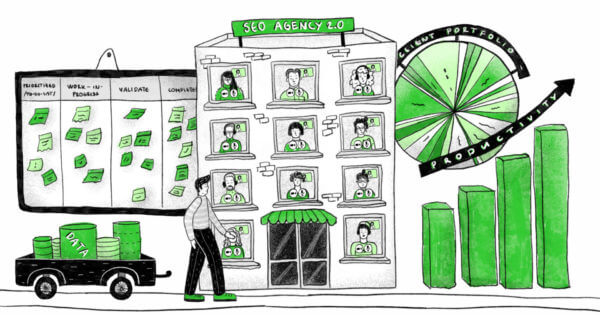How to (re)build an SEO agency today – Part 3: Changing business models
Without in-person meeting, curating client relationships with more attention in the digital landscape is crucial for retention.
How would an SEO agency be built today?
This was the challenging question behind our three-part analysis on the state of SEO agencies in an uncertain 2020. Our team at SEOmonitor designed this strategic experiment to support agency leaders think about the forces influencing their business and where the opportunities lie in optimizing or evolving their agencies.
Firstly, we explored consumer and business trends since the pandemic started, to understand how the markets and behaviors shifted. Then, we analyzed about 36,000 SEO and digital marketing agencies worldwide to highlight their current business models, using Osterwalder’s Business Model Canvas (BMC) tool.
To end our strategic thought experiment, we’re asking What’s next for the SEO industry and how can SEO agencies evolve in the new context? We’ll explore the answer by looking at business trends with a high impact on the SEO industry, making sense of the Business Model Canvas — your agency current state and what you can change —, and bringing them together.
We’re basing our insights from research, interviews with SEO experts, and practical examples found during our Circle sessions — a mastermind-like workshop for agency founders and top managers to work on pressing matters. Mainly, the ones focused on the future of agencies and the BMC with Luke Lauer (Managing Director at TitanGrowth), Greg Walthour (CEO and Founder of SocialSEO), James Finlayson (Head of Strategy at Verve Search), Nick Wilsdon (Senior Partner at TorquePartnership), Radu Marcusu (CEO at Upswing) and Cosmin Negrescu (founder of SEOmonitor and an SEO agency).
Let’s begin!
Business trends that influence SEO agencies
Narrowing the lens on the consumer and business trends that we’ve tackled in the first part of this trilogy, you need to start addressing the ones relevant to building an SEO agency today. And, more importantly, establish which are here to stay and which are just a fad with no long-term implications.
This is one important step in understanding the new context that shapes the business. To help you see clearer, don’t forget to place them on Gartner’s Hype Cycle — an innovation curve that indicates whether it’s just hype surrounding a particular trend or it’s getting productive and mainstream.
That’s how you consider the trend’s scale and its second-order effects — the string of consequences a trend has, that are not visible at first glance. Remember Henry Ford’s innovation in producing serialized automobiles? A second-order effect that the accessibility of automobiles brought was actually in retail, as people could travel further and carry more products, so bigger convenience stores could be developed.
A good question to ask at this point is What are the potential consequences of a system/market change you’re considering? And what are the consequences of those consequences?
Remote work
Here’s a trend with a long-term impact, which is definitely here to stay as more and more companies are transitioning to full-time policies of remote work.
For an SEO agency that can mean a rise in productivity, yet it also implies new ways of doing recruitment or new business which need creative solutions. There is a slope of disillusionment implied here, as teams start feeling the fatigue of Zoom meetings, and other disadvantages like a lack of proper office setup or increased work hours.
A potential second-order effect, in this case, is a change in the agency workflows — maybe transforming some parts of the creative process into an asynchronous one. But this means taking care not to affect creativity or the feeling of belonging in the team, as it can backfire without the synchronous brainstormings and workshops.
Also, when it comes to hiring, remote work may mean a real threat in losing staff — people are more accessible now than pre-March. SEO agencies need to find ways to keep their culture while online. It may as well be an opportunity to enhance company culture and access top talent on a global level.
Agile planning acceleration
Digital transformation has been pushed at the forefront of many businesses, as online consumption spiked out of necessity. Because of this, business operations had to embrace agile planning, going from monthly cycles to even weekly cycles, as Nick Wilsdon pointed out during a Circle meeting.
This is probably another trend that is here to stay, which opens the door for agencies transforming their implementation-only status into a more consulting role — helping businesses accelerate their digital systems with know-how and specific search data.
There’s an interesting second-order effect that could happen as SEO agencies take on a more strategic and consultative place. Strong competition between the traditional consultancy firms and the transformed agencies throughout the market could ensue.
Leveraging search data
Another trend that accelerated throughout the pandemic, that Google also highlighted for businesses, is the importance of search data in determining thriving markets or significant consumer behaviors.
Probably here to stay, the leverage of search data can go beyond the strategic level and inform how businesses transform their operations. For instance, as Nick Wilsdon further pointed out, analyzing search data to understand the customer journey and what people are asking about a certain business can inform customer support and their new frequently asked questions materials.
Again, the SEO agency’s supporting role at a general business level can continue to grow.
Yet, a second-order effect can see the rise of a new type of company that only leverages search data for sophisticated research — consulting firms using search data for business analysis, without any direct relationship with SEO.
These are some of the main trends we uncovered. You can continue this exercise of current trends analysis with what you discovered and what the consequences could be, until you find 3-5 significant trends for your agency context.
Actionable business trends and the new business model canvas
With your actionable business trends explored, it is time to create a new business model canvas, guided by the idea of how an SEO agency with significant resources can be shaped in today’s world.
In short, the Business Model Canvas or BMC designed by Alex Osterwalder is a strategic tool that helps you present an existing business model and make it practical for all the agency’s stakeholders. It is also a tool that enables you to think in the future and create patterns between its building blocks of customers, channels, activities, revenues, and more.
Think about the business trends you’ve discovered
This intermediary step is one that we, at SEOmonitor, introduced to help you be mindful of the external forces influencing your choices.
So which ones are relevant for shaping a better business model for the agency?
For instance, in our debate with TitanGrowth’s managing director, Luke Lauer, he mentioned hedging as an interesting trend of risk management. In investment, hedging means protecting your portfolio by taking an opposite position in a related asset. If you see a negative impact on your current X stock, you don’t sell, but invest in a different Y stock that will reduce your risk of loss. As an agency, hedging can imply diversifying your client portfolio — because you never know which industries could be affected in the future, you can treat your portfolio like an index of multiple industries to target.
Choose customer segments and connect them with your value proposition
See how a big trend like remote work can affect both the SEO agency and a possible customer that had to adopt it. Would they want to work with an agency that has a client service team covering all timezones? Maybe you can highlight your distributed team and multiple markets know-how as a key proposition, and even target brands that have international coverage.
If you choose hedging as a lens, there are multiple ways to go about it: getting more clients, probably coming from tech and eCommerce, or targeting brands that need to make this transition. Attacking more verticals than before, to have a diversified portfolio in that respect, and offering them your data know-how. Or diversifying your services which can become a transition to a more consultative role or an integrated digital marketing positioning — another potential differentiator in today’s global market.
Think about new channels and customer relationships
Once you’ve established the targeted customer segments and the key proposition that differentiates you in solving their particular problem, it’s time to address how you want to build relationships with them and which channels you can use to reach them.
The pandemic made Zoom one of the most sought after channels — weekly video calls are the norm in taking the customer’s pulse and managing their projects. With agile planning in sight, this means a closer relationship between the agency and the company, while coordinating in sprints and becoming more strategic about SEO. Maybe even considering having a project manager working directly with the client or an SEO specialist at their disposal for fast decision making on both sides. It also means being present in the client’s internal channels, whether Slack or other messaging channels they work with, to intervene fast, point out opportunities, and show you care.
You can go even further, as Greg Walthour mentioned, and appoint a Customer Satisfaction Manager auditing each client relationship and ensuring potential frustrations and conflicts are mitigated in time. Without an in-person meeting, curating client relationships with more attention in the digital landscape is crucial for retention.
The pandemic also took offline events out of the picture for some time, which was an important business development channel for agencies and companies alike. Radu Marcusu pointed out how they moved their Upswing Power Sessions online from the start of the lockdown, managing to gather over 350 qualified participants who didn’t have any contact with their agency before — a better targeting method, as well.
Now is a good opportunity to leverage data-driven outbound marketing for the agency, and even think about experimenting with the sales funnel and automation in qualifying your leads.
Data-driven outbound would take into account far more variables when thinking about potential customers and your lead generation efforts. Traditionally, agencies would target based on revenue, yet now you have access to things like the technology that is powering the client’s whole website (e.g. Drupal), year-over-year shifts in their keywords or their monthly market share (YoY Trends). That can be leveraged for highly-targeted messaging, better choosing your marketing channels, and presenting specific offers from the get-go.
Connect your new key activities with resources and partners
Once you know how to reach your designated target and what you want your key messages to be, you need to think about the changes in your agency’s key activities, resources, and partners.
Consider hedging again, in terms of new services, thus new key activities for your SEO agency — you could integrate paid search, digital PR, or training and consultancy. Or even expand your agency with an Analytics department for both your clients, and internal research and development.
This implies different resources you need to take into account (new hires, new software etc.) or extending your partnerships with software providers, freelancers, or other specialized agencies.
Also, remote work comes into play and poses new challenges for your key resources and culture — on the one hand, good specialists are now reachable from any part of the world, but on the other hand, recruitment and onboarding become more difficult.
Juniors, for example, need more direct contact with their seniors and teams to grow in their position. Plus, how do you hire for culture fit?
You can think about longer onboarding periods, hiring an HR consultant, or developing new online tactics for people management (informal Zoom rooms, virtual mentorship programs etc.). Or you can orient your hiring efforts to experts and project managers that have the experience and autonomy required in the current context.
This is a good time to start building processes and templates that make your culture more palatable and scalable.
And, if you think in terms of heightened digital adoption, you can evaluate key partners that can refer you, such as traditional agencies in need of SEO complementary services or VC groups supporting new tech ventures and SaaS companies in need of speed and agility. It’s also a good point for investing more in your reputation management activities altogether — the kind of marketing or PR you do for your own agency, the awards and accolades you showcase, the relationships you’re building, as everything is digital and visible. Don’t miss out on media coverage and award ceremonies opportunities, for they are more valuable in the actual context.
Analyze your costs and revenue streams
Getting your other building blocks in order, it is finally time to look at cost structures and revenue streams.
Remote work brings a drop in costs for office space and commute, but can imply new types of packages for your employees. For instance, a budget to set up the team’s home office or to cover a percentage of utility bills (electricity, IT infrastructure etc.). Or, in order to cultivate culture, periodical company retreats that combine strategic work with team building activities.
If you choose hedging, then new resources and new partnerships developed with your agency expansion become new costs in terms of salaries, software subscriptions or subcontractors. In turn, diversifying your services with monthly offerings and/or your client profiles or verticals means new revenue that supports your MRR (monthly recurring revenue) growth.
Leveraging your data and analytics skills in itself can become a new revenue stream, if you decide to offer consultancy and training for SMBs and enterprises.
Or maybe you develop a proprietary tool. At first, it’s an investment which alters your cost structure, but can transform into a new business channel at the same time.

Applying BMC to your agency – Shifting business models
The point of doing this strategic exercise is, in the end, to see how they’re all connected — macro-trends affecting the globe, business trends relevant to the SEO industry, and every segment of an agency business model that can suffer changes and unexpected transformations.
Osterwalder continues to document shifting business models, as the BMC is a tool to be used multiple times in the life of your agency. You can take your leadership team and consider this an exercise in change management — understanding how every part of your agency business can transform and what that means to the business as a whole.
As the market changed dramatically in the last few months, it’s an opportunity to understand how your business model can shift and what’s next for the SEO industry after COVID-19.
At SEOmonitor, we’re committed to helping SEO agencies navigate uncertainty, so we adapt our solutions to the current context. Search Trends, the Client Health Tracker or the Reporting board are just a part of our specialized tools and resources.
We’re also continuing these thought experiments with more agency founders and top managers in the Circle, to help agencies focus on what matters now. You can find out more about the selection process and topics in the following material.


